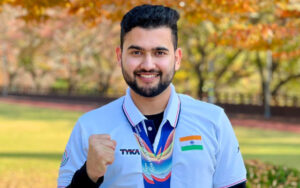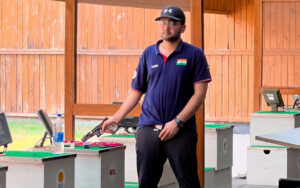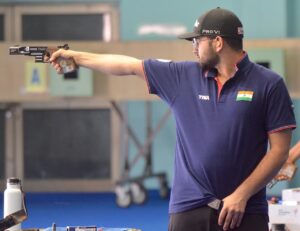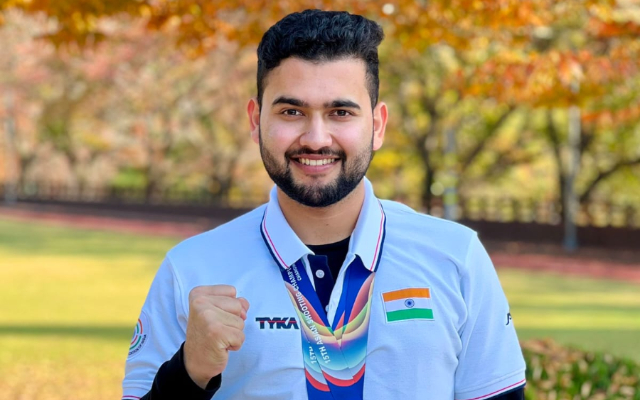
Anish Bhanwala and simplicity are an amalgam. As the 21-year-old came out smoking in the rapid-fire pistol trials for the Paris Olympics, what stood out was his maturity and coolness. The fourth trial final ended in Bhopal on Tuesday, and Anish was soon ready to drive back to his hometown in Haryana. It’s a good ten-hour drive, with his Dad at the wheel.
“This has been my journey – long drives, then unpack at the range and then fire,” said Anish, relaxed after he could do well in the four trials held in New Delhi and Bhopal. In sport, pressure is more often described as something which can “kill” an athlete.
But Anish is cut from different fabric, and he says pressure goads him to do well. “It’s a new thing this, trials before the Olympics in India,” he said. “I would say much needed, and I am all for it. I know they have seven trials before the Olympics, so I had to get used to it as well.”
Rapid fire pistol is one of the oldest events in the Olympics programme, part of it since the first modern Games in 1896. For those not familiar with this technical sport, the marksman has to be razor sharp. He gently squeezes the trigger, with a firm grip on the pistol. The 0.22 cartridges come out at a minimum velocity of 250 metres per second. The cartridge is imported, weighs approximately 40g and is fired from a magazine loaded with five of them.
For the Latest Sports News: Click Here

From the time the ‘load’ command is given till the marksman press the trigger, the loud sound, almost a boom, will hurt your eardrums. If you love shooting as a sport, the rapid-fire pistol will result in a faster heart rate when you watch it live from the stands.
“No, not for me,” said Anish with a laugh. “I believe in more cardio training and not doing overtraining in the gym. Cardio helps me in keeping a low heart rate, so important.” He would not share too many details. What is his [resting] heart rate? “It’s around 50, my heart rate,” said Anish. “This helps me be calm.”
How does calmness, heart rate and pressure add up? “You are grilling me, Sir, I love it,” said Anish. “Yes, people look at me and think I am not the fittest. Let me also say I do cardio, pranayama (anulom and vilom) and then there is pressure. This pressure is important, this pressure brings the best out of me.”
Would he say he thrives under pressure? “Yes, when the first trial was held in New Delhi, I was ready for more pressure even though I had a shaky start,” he said. “I knew I had to enjoy this pressure in four matches, something which would ensure I am going to be the best. I enjoyed it, this pressure. If not, I will not be slogging to win an Olympic quota and then prove that I am the right guy to fly to Paris.”
Does he feel there is plenty of strength at home in shooting, more so in rapid fire? “We have depth, we have a talent base, and we had the Olympic trials,” said Anish. “I am happy the shooters who were part of the trials got to prove themselves. I think, in the past, there was this general impression that once a quota was won by a shooter, form before the Olympics was not important.

“I mean, if I look back at the Tokyo Olympics three years ago, I was really young (18). Those were my teen days and the situation very different because of Covid. I am better prepared today and can only promise my best effort in Paris.”
This is a young man who does not open up easily. Then again, he has switched off from social media for the last four months, as suggested by his coach Harpreet Singh. For Anish, Harpreet is a Guru, someone whose feet he touches whenever he sees him. It’s massive respect, plus implicit faith.
“Yes, I sought to train from a young age with Harpreet Sir as he lives close to my place in Haryana,” said Anish. “He was also there for my trials.” At the same time, Anish also knows that to further hone his skills, he has to trust in the methods and strategy taught by legend Ralf Schumann. The 61-year-old is a three-time Olympic champion and also two-time world champion. “Yes, I am in touch with Ralf,” said Anish. “I am hoping I will get time to train with him before Paris. The NRAI and the SAI are involved in planning.”
Eight-second series, six-second series, four-second series – all these go into a rapid-fire match. Anish explained a few things about what all are needed to be good in this discipline. “Technique is vital and then balance,” he said. “I mean, the way I stand, balancing my body, stability and then shoot – all this has to be in sync. It has taken hours and hours of practice. I never tell myself I am the best. I tell myself I will keep improving.”
Also Read: FedCup Athletics review: Neeraj Chopra steals the thunder after Abha Khatua’s national record




